King Air down at Essendon?
It’s not a flight manual requirement for the aircraft in question either.
There are certain ‘old school’ habits that I prefer to mere blind adherence to the bare minimum that may or may not be listed in check lists or the AFM. First fllight of day checking trims through full range serves two useful purposes. 1. it ensures cables, pulleys, actuater rods and tabs are not binding and 2. reinforces pilot ‘muscle memory’ so that the lesser used of those controls can be found without looking. Only this week I caught a partially seized trim circuit in an old aircraft and which is still under investigation. Also the crossfeed function is worth checking on every aircraft type, yet often this won’t be called up except as a maintenance check. The maintenance check itself may only occur at six or twelve month intervals. Use it or lose it.
But another old school habit needs to be to not accept any interruption to your workflow or whatever habit pattern you use to prepare for flight. Today that includes ignoring your mobile phone. Some people have a real problem with that.
Not saying this is what happened here, but it does seem from reports of doors and lockers left open that the pilot lacked organisational discipline.
But another old school habit needs to be to not accept any interruption to your workflow or whatever habit pattern you use to prepare for flight. Today that includes ignoring your mobile phone. Some people have a real problem with that.
Not saying this is what happened here, but it does seem from reports of doors and lockers left open that the pilot lacked organisational discipline.
I think this accident demonstrates just how detrimental gross sideslip can be, lucille. Take a look at figure 20 on page 25 of the report. Positions 5 and 6 show the aircraft appears to be going almost sideways. You will have to zoom in on the image.
a) flown the accident profile in the SIM (which they didn't because they recorded airspeeds in excess of 140 kt and the accident aircraft never got above about 112 kt.
b) done a real flight in a B200 and at a safe altitude tried winding on LH rudder trim
The pixel analysis has large potential error. The report tables the margin for errors, which I think are understated because I think they have only considered an error of +/- 1 pixel rather than cumulating the potential 1 pixel arror of all the points they used for angle calculation. But the side slip performance speculation uses only the worst case of the estimated side slip angles.
If you do your own calculation of the fuselage angle as it hit the DFO building (based on the angle the fuselage centreline makes with the propellor cuts) it doesnt correlate with the report, I get less side slip angle than the report. Which once again challenges the fundamental thesis of the report. The propeller cuts change angle significantly after the 4th cut (one propeller revolution or about 0.03 seconds after first contact) where I presume the aircaft started to yaw due to contact with the building. I'm suspicious that the ATSB used an average of the propellor cut angles rather than using the best defined of the first 4.
Its worth noting that in one of the US B200 accident reports that the pilot did maintain directional control despite full LH rudder trim. Which once again brings into question the fundamental premise of the report and supports the suggestion that directional control could have been maintained if the only problem was incorrectly set trim.
Join Date: Apr 2008
Location: Australia
Posts: 669
Likes: 0
Received 0 Likes
on
0 Posts
Its worth noting that in one of the US B200 accident reports that the pilot did maintain directional control despite full LH rudder trim.
There was also a reference to a C90 King Air in the USA but that is a different aircraft and the rudder trim was set in the opposite direction (that aircraft was able to get back around and land mostly safely).
Note that full NL rudder trim is more hazardous than full NR trim on the B200, due to the aerodynamic "p effect" where the propeller thrust line is shifted to starboard, increasing the NL yaw moment.
Interesting the same checks are not required in airline types. You don't see a 737 crew running the stabiliser trim right through the full range of movement as part of the preflight. And that is a huge range of movement. Nor the rudder trim which takes 29 seconds from neutral to one side and same to the other side. Nor the full available range on the aileron trim either. Of course it might be required for a C or A test flight but not on line flights .
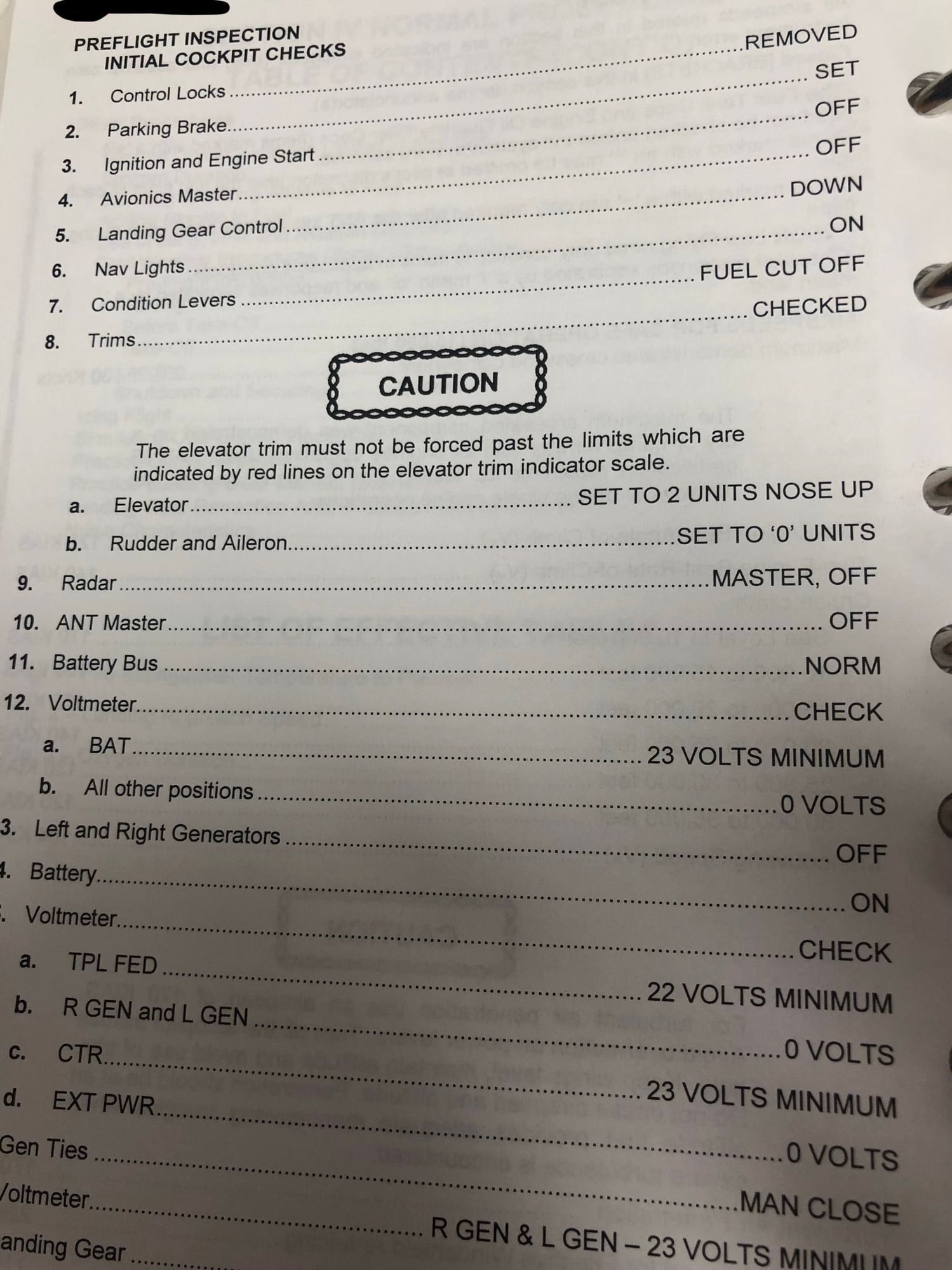
Flight manual (350): Preflight Inspection Initial Cockpit Checks.
Trims: Checked
Caution: the elevator trim must not be forced past the limits...
a) elevator - set two units NU
b) Rudder and Aileron - set to zero units.
My operator does a full range of motion check on first flight of the day, regardless, the checklist speaks for itself in terms of bringing the rudder back to zero.
A likely sequence of events is as the right rudder load was increasing during the takeoff roll toward full rudder deflection upon becoming airborne, the pilot has diagnosed a left engine failure on the strength of required rudder force alone, he's reduced thrust on the left engine, when that has made the condition worse he didn't know what to do next in the remaning few seconds. The initial slash marks in the roof which is first contact imply a fine pitch blade angle (low torque). It would account for the reducing speed and failure to climb. Because he didn't retract the gear the failure was progressive and not one we train for. As speed increased during the takeoff roll, this would have caused confusion. I'm of the view he perceived he was dealing with a left engine problem which overwhelmed him in the time available.
Which incident are you referring to here, Old Akro?
The report notes: "The Hawker Beechcraft investigator stated that the position of the right propeller lever “…would cause the right engine to reach a higher torque because the propeller is now on the primary governor. The result would be a yaw in a left direction.” "
So, this aircraft should have had a much larger left yaw than ZCR, yet it basically crashed on runway heading, suggesting that the pilot had directional control.
The NTSB report did not attribute a cause of the accident to any particular one of the mis-set controls, but the pilot said: " The pilot added that he had both hands on the yoke until the airplane crashed. " which infers that it was not the rudder correction that was his main struggle.
By comparison with the US B200 which crashed 4420 ft from lift off 10 deg of runway, ZCR crashed about 1500 ft from lift off and about 40 deg from runway heading. There is no indication in the report that the US B200 climbed above 100 ft. ZCR achieved about 650 ft before descending.
The two incidents barely seem analogous. and I think the US incident suggests that directional control can be maintained despite full left rudder trim. It would have been good if the ATSB tested this
Join Date: Apr 2008
Location: Australia
Posts: 669
Likes: 0
Received 0 Likes
on
0 Posts
Old Akro,
You are consistently misrepresenting and misquoting these reports. You're definitely pushing an agenda, but we're onto you.
In your first post this morning, you stated that the pilot "did maintain directional control, despite full NL rudder trim". This is a misrepresentation. If you use Google Earth to look at the runway in question, and the two buildings this aircraft collided with, you will see that the veer to the left after takeoff appears almost identical to that by ZCR. That is not what most people would consider "maintaining directional control". My Google Earth is playing up, but if you want me to take some precise measurements for comparison with ZCR, I will find a way to do so.
The condition levers had no bearing on the outcome. The RH prop lever, however, may have had some bearing, but it must be noted that this was how the lever was found in the wreckage - no analysis appears to have been conducted as to whether it was in this position during the takeoff.
This is not true. At best, the power output of the RH engine would have matched the LH, or it may have been less. It all depends on when the lever was put in that position, relative to when the takeoff torque was set.
If BEFORE the torque was set, then the pilot most likely advanced both power levers to the target takeoff torque (2,230 ft-lbs), as normal, but if the RH prop lever was in the reported position, then the RH RPM would not have come up to 2,000 RPM. It would have got to only about 1,800 (my estimate). In this case, the RH engine is actually producing LESS power than the LH.
If the lever was positioned AFTER the torque was set, then yes, the torque of the RH prop is increased - but the RPM is reduced, with the result that the power output is about the same. So, in neither case would the reported position of the RH prop lever have caused an increase in the NL yaw moment.
I imagine the tendency to roll L would be very strong in these instances, and with the low airspeed, may well have required full R aileron.
As I stated above, the veered path appears almost identical to ZCR. The buildings in the US case were much closer, and appear to be lower. Until I make some measurements, it appears to me that the only difference between these two accidents was that the US aircraft was about 50-60 feet lower than ZCR at the same point.
Disagree - and all the evidence disagrees with this assertion.
You are consistently misrepresenting and misquoting these reports. You're definitely pushing an agenda, but we're onto you.
Report WPR09LA451. B200 Kingair.
The rudder trim was full left AND elevator trim 9 degree nose up (should have been 2-3) AND the RH propeller " one half inch forward of the feather position" AND both power levers were one inch aft of the full power setting. AND the left condition lever was in the low idle position while the right condition lever was in the high idle position.
The report notes: "The Hawker Beechcraft investigator stated that the position of the right propeller lever “…would cause the right engine to reach a higher torque because the propeller is now on the primary governor. The result would be a yaw in a left direction.” "
If BEFORE the torque was set, then the pilot most likely advanced both power levers to the target takeoff torque (2,230 ft-lbs), as normal, but if the RH prop lever was in the reported position, then the RH RPM would not have come up to 2,000 RPM. It would have got to only about 1,800 (my estimate). In this case, the RH engine is actually producing LESS power than the LH.
If the lever was positioned AFTER the torque was set, then yes, the torque of the RH prop is increased - but the RPM is reduced, with the result that the power output is about the same. So, in neither case would the reported position of the RH prop lever have caused an increase in the NL yaw moment.
The pilot added that he had both hands on the yoke until the airplane crashed. " which infers that it was not the rudder correction that was his main struggle.
By comparison with the US B200 which crashed 4420 ft from lift off 10 deg of runway, ZCR crashed about 1500 ft from lift off and about 40 deg from runway heading. There is no indication in the report that the US B200 climbed above 100 ft...
I think the US incident suggests that directional control can be maintained despite full left rudder trim.
Join Date: Dec 2017
Location: At Home
Posts: 29
Likes: 0
Received 0 Likes
on
0 Posts
And once again from me:
If you Keep a B200 with 2 Engines running below 160ft, after 5100ft distance you are going the better of 160kts even with the gear down.
If you Keep the Speed below 110kts, wich almost no one would do ( read below), the Ship would climb at an unsane angle.
In Europe, "Norwegian Air Transport" trains to climb at V2. Everybody else i know, trys to get to Cruiseclimb as fast as possible. To build up some kinetic Energy and to pass 121KT= V2 Flaps up, to raise the flaps (( 1% mor Gradient)), wich happens usually around 50ft AGL
Unfortunatly the B200 i fly is in Maintenance/Repair, otherwise i would try the Scenario at an safe Altitude and Report.
Slighly Off Topic, but related to the Accident:
The reason i dont like to climb with V2 on an 2 Engine Departure is: You are maintaining an Pitch Attitude of give or take 20degr. @ 121KTs clean( Stall Speed 100kt ...). Now one Engine quits and you Need to decrease your pitch to 10degr. while the Aircraft is getting slower and trying to roll on its back. All the Odds are against you in this Scenario.
Every knot of Speed you carry more is just safety! If you climb out with 10degr. you do 160kts, the recommended Cruise climb.
If you loose an Engine above V2se, just maintain Pitch - Keep Directional Control, wich is easier because of reduced Torque effects - Clean up - Check Autofeather in Progress and relax!
I just dont buy the conclusion of this Accident Report. It might even happened that the Pilot has put the trim in the wrong direction while airborne. I have seen this happen with unexperienced Copilots, until it settled into them wich direction to turn. Usually they werent used ( or trained) to work the Ruddertrim and where at first annoyed to get ordered to trim "all the time".
If you Keep a B200 with 2 Engines running below 160ft, after 5100ft distance you are going the better of 160kts even with the gear down.
If you Keep the Speed below 110kts, wich almost no one would do ( read below), the Ship would climb at an unsane angle.
In Europe, "Norwegian Air Transport" trains to climb at V2. Everybody else i know, trys to get to Cruiseclimb as fast as possible. To build up some kinetic Energy and to pass 121KT= V2 Flaps up, to raise the flaps (( 1% mor Gradient)), wich happens usually around 50ft AGL
Unfortunatly the B200 i fly is in Maintenance/Repair, otherwise i would try the Scenario at an safe Altitude and Report.
Slighly Off Topic, but related to the Accident:
The reason i dont like to climb with V2 on an 2 Engine Departure is: You are maintaining an Pitch Attitude of give or take 20degr. @ 121KTs clean( Stall Speed 100kt ...). Now one Engine quits and you Need to decrease your pitch to 10degr. while the Aircraft is getting slower and trying to roll on its back. All the Odds are against you in this Scenario.
Every knot of Speed you carry more is just safety! If you climb out with 10degr. you do 160kts, the recommended Cruise climb.
If you loose an Engine above V2se, just maintain Pitch - Keep Directional Control, wich is easier because of reduced Torque effects - Clean up - Check Autofeather in Progress and relax!
I just dont buy the conclusion of this Accident Report. It might even happened that the Pilot has put the trim in the wrong direction while airborne. I have seen this happen with unexperienced Copilots, until it settled into them wich direction to turn. Usually they werent used ( or trained) to work the Ruddertrim and where at first annoyed to get ordered to trim "all the time".
We all have an ‘agenda’, FGD.
Your ‘agenda’ is to defend a report that reaches the oh-so-convenient conclusion that the only hole in the Swiss cheese was the pilot.
Others like me (and I suspect OA) have an ‘agenda’ of testing the reasoning and findings of an oh-so-compromised ATSB.
I for one do want you to “take some precise measurements [of the details of the B200 accident with report number WPR09LA451] for comparison with ZCR”, so please “find a way to do so” on google maps. I’m surprised that more detail of the US accident were not included in the ZCR report, if the path of the aircraft in US accident was, in fact, so similar to that of ZCR.
Your ‘agenda’ is to defend a report that reaches the oh-so-convenient conclusion that the only hole in the Swiss cheese was the pilot.
Others like me (and I suspect OA) have an ‘agenda’ of testing the reasoning and findings of an oh-so-compromised ATSB.
I for one do want you to “take some precise measurements [of the details of the B200 accident with report number WPR09LA451] for comparison with ZCR”, so please “find a way to do so” on google maps. I’m surprised that more detail of the US accident were not included in the ZCR report, if the path of the aircraft in US accident was, in fact, so similar to that of ZCR.
Join Date: Aug 2011
Location: Australia
Posts: 423
Likes: 0
Received 0 Likes
on
0 Posts
it inexorably follows that the previous hole was the trim being set to full deflection before the flight. Be good to know who and why.
See: https://en.wikipedia.org/wiki/Helios_Airways_Flight_522. The crew took off unpressurised because neither pilot noticed during their preflight the pressurisation selector was set to Manual and not Auto then further failed to compete the after take off checklist properly so missing the lack of pressurisation for the second time (complacency by the captain for not monitoring the actions by the F/O).
The pressurisation controller had previously been set to Manual during a trouble check by servicing personnel. They omitted to set it back to Auto afterwards. Of course it should have been picked up during the crew preflight checks but both the captain and first officer were slack in their job and missed the fact the selector was still in Manual. But at least the culprit was known to be the maintenance staff. Nothing has come to light in the King Air accident who set the rudder trim full scale left. Not that it affect the final outcome though.
Join Date: Apr 2008
Location: Australia
Posts: 669
Likes: 0
Received 0 Likes
on
0 Posts
As requested, I have done some work with Google Earth to compare the flight paths of VH-ZCR and N726CB, the latter being the King Air B200 that took off from Hayward Executive airport, California on 16/9/2009, with full nose-left rudder trim.
N726CB veered left after becoming airborne and struck the roof of a 10 metre high (estimate) building. The point of impact was 15 degrees off the runway azimuth, at a distance of 670 metres - measured from the lift-off point. I have assumed a distance of 500 metres for this takeoff roll (see attached image).
For the takeoff of VH-ZCR, I have drawn a line of the same vector onto the Essendon image, to see how close the two impact points are (see image).
The two points are about 150 metres apart. ZCR has veered more, which could be explained by its 15 knot greater airspeed at lift-off (assuming that N726CB rotated at a normal speed). The greater airspeed would give a greater initial nose-left yawing moment.
Another possible explanation: the pilot of N726CB had 37 year old knees, as compared to the 76 year old knees in ZCR.
The distance from lift-off to impact for N726CB was about 670 metres. For ZCR, this distance was about 620 metres.
The biggest unknown in this exercise has been the length of the takeoff run for N726CB. I have assumed 500 metres, but if that actual takeoff had got off to a more leisurely, rolling start, then this distance could have been closer to 600 metres, which would have put the endpoints of the two vectors within about 75 metres of each other.
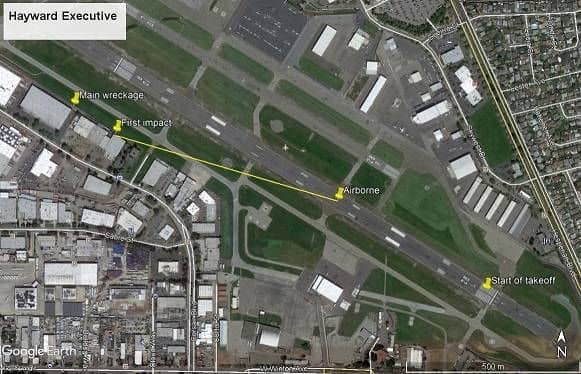
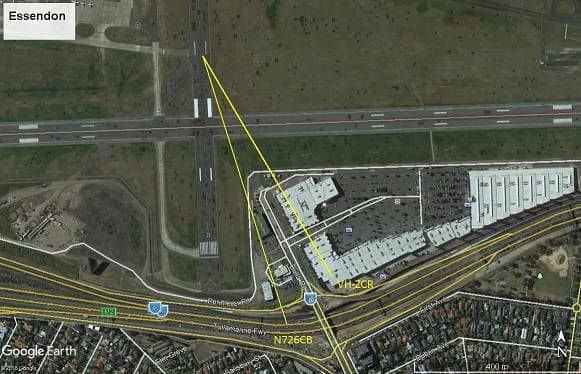
Those wishing to check my work should have a look at this image, from the NTSB:
https://aviation-safety.net/photos/displayphoto.php?id=20090916-0&vnr=1&kind=G
N726CB veered left after becoming airborne and struck the roof of a 10 metre high (estimate) building. The point of impact was 15 degrees off the runway azimuth, at a distance of 670 metres - measured from the lift-off point. I have assumed a distance of 500 metres for this takeoff roll (see attached image).
For the takeoff of VH-ZCR, I have drawn a line of the same vector onto the Essendon image, to see how close the two impact points are (see image).
The two points are about 150 metres apart. ZCR has veered more, which could be explained by its 15 knot greater airspeed at lift-off (assuming that N726CB rotated at a normal speed). The greater airspeed would give a greater initial nose-left yawing moment.
Another possible explanation: the pilot of N726CB had 37 year old knees, as compared to the 76 year old knees in ZCR.
The distance from lift-off to impact for N726CB was about 670 metres. For ZCR, this distance was about 620 metres.
The biggest unknown in this exercise has been the length of the takeoff run for N726CB. I have assumed 500 metres, but if that actual takeoff had got off to a more leisurely, rolling start, then this distance could have been closer to 600 metres, which would have put the endpoints of the two vectors within about 75 metres of each other.


Those wishing to check my work should have a look at this image, from the NTSB:
https://aviation-safety.net/photos/displayphoto.php?id=20090916-0&vnr=1&kind=G
Last edited by FGD135; 27th Sep 2018 at 16:23.
Thanks FGD.
I acknowledge the similarities. But I don’t see too much precision in stuff like:
“I have assumed a distance of”,
“could be explained by”
“Another possible explanation”
“The biggest unknown”
“could have been closer”
All of your assumptions and reasoning may be reasonable. But they may also be wrong in fact.
The difference between our approaches is that all of your assumptions and reasoning are in one direction, to make the two incidents as similar as possible and thereby to ‘prove’ the two incidents had the same cause. My (and I suspect OA’s and others’) approach is to ask: What if your assumptions, possible explanations and known unknowns turned out to show substantial differences between the two incidents? Frankly, the latter approach is the one that ATSB should take, rather than jump to a conclusion then find as much stuff to support that conclusion, even if it means making assumptions that may be invalid and positing explanations that could be wrong.
I apologise if you’ve already answered these questions, but what is your theory as to who set the trim to full NL, when and why? I realise that these questions are irrelevant for those who consider there is only one hole in the Swiss cheese in this tragedy, but they are not irrelevant to others. You’ve said you don’t believe that the pilot set the rudder trim to full NL during pre-flight checks then failed to set it correctly due to distraction. If you are correct, it inexorably follows...
I acknowledge the similarities. But I don’t see too much precision in stuff like:
“I have assumed a distance of”,
“could be explained by”
“Another possible explanation”
“The biggest unknown”
“could have been closer”
All of your assumptions and reasoning may be reasonable. But they may also be wrong in fact.
The difference between our approaches is that all of your assumptions and reasoning are in one direction, to make the two incidents as similar as possible and thereby to ‘prove’ the two incidents had the same cause. My (and I suspect OA’s and others’) approach is to ask: What if your assumptions, possible explanations and known unknowns turned out to show substantial differences between the two incidents? Frankly, the latter approach is the one that ATSB should take, rather than jump to a conclusion then find as much stuff to support that conclusion, even if it means making assumptions that may be invalid and positing explanations that could be wrong.
I apologise if you’ve already answered these questions, but what is your theory as to who set the trim to full NL, when and why? I realise that these questions are irrelevant for those who consider there is only one hole in the Swiss cheese in this tragedy, but they are not irrelevant to others. You’ve said you don’t believe that the pilot set the rudder trim to full NL during pre-flight checks then failed to set it correctly due to distraction. If you are correct, it inexorably follows...
Good analysis FGD and eerily similar indeed, especially if thatís 100% confirmed as to what happened to the N reg aircraft.
junior.VH-LFA, your photograph tells me it is from a simmers program, for two reasons, first it has no providence, secondly it makes absolutely no mention of the electric trim. See page 1 of the attached.
To all, the points in the check list where trims get a mention.
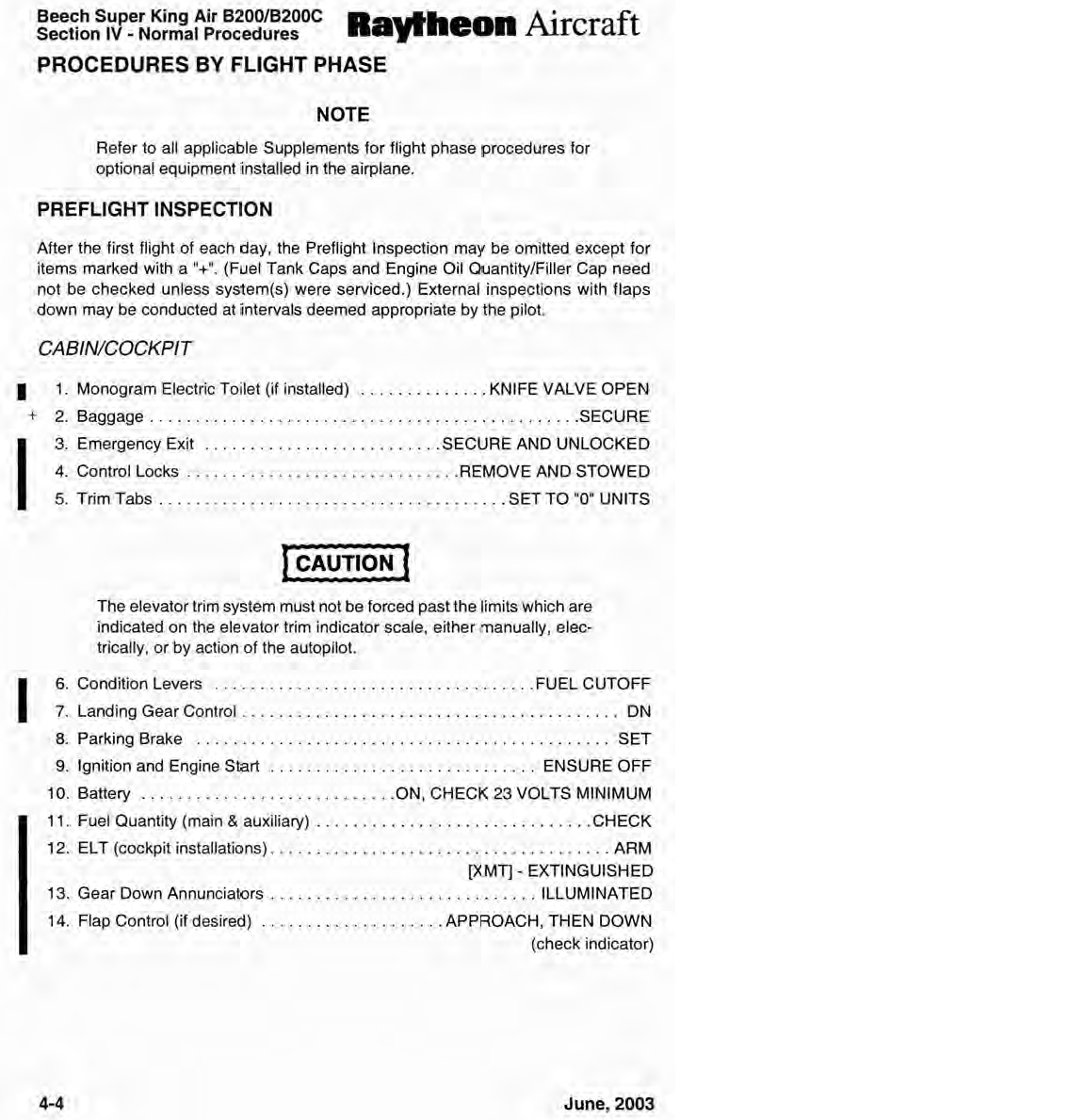
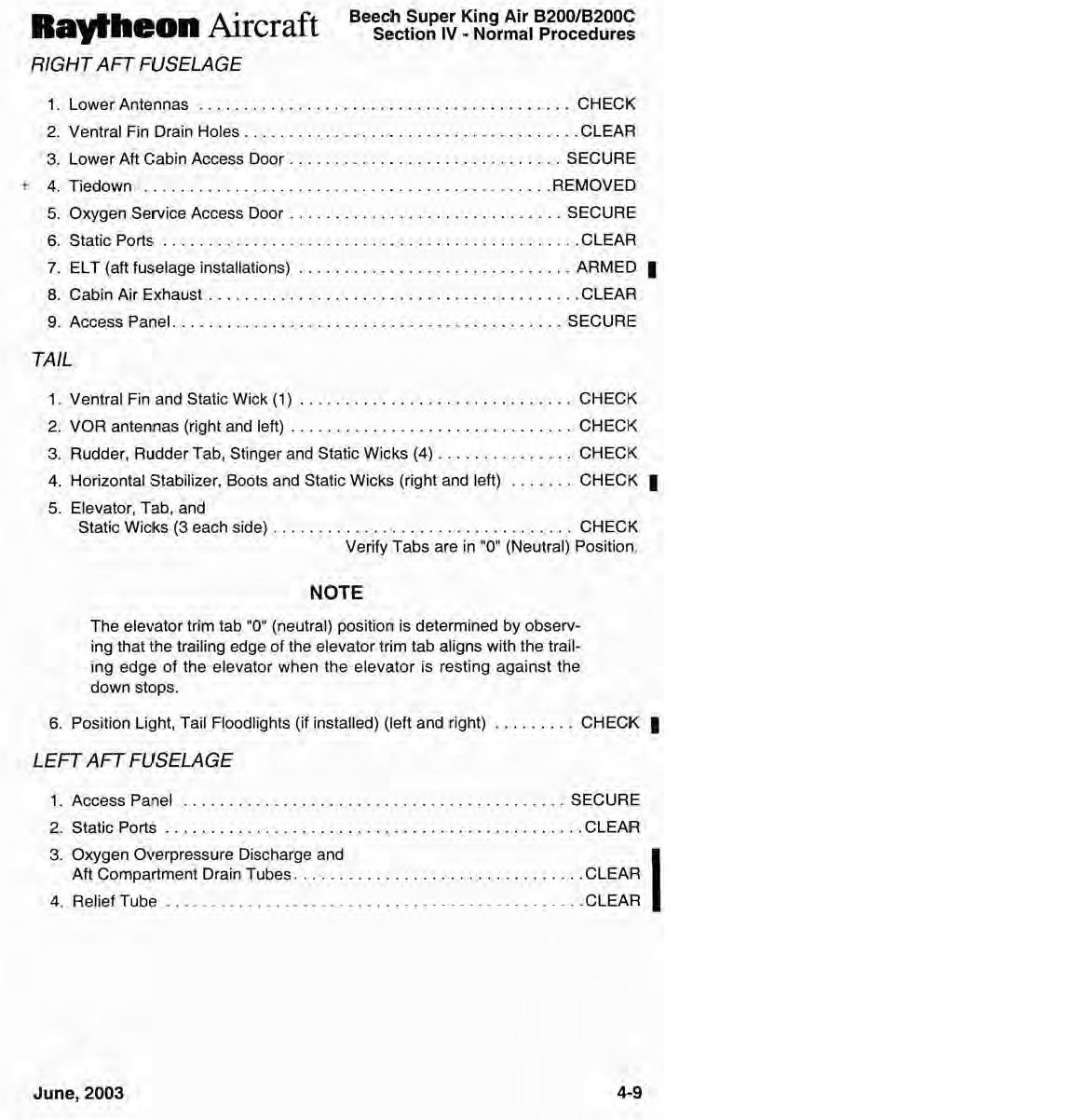
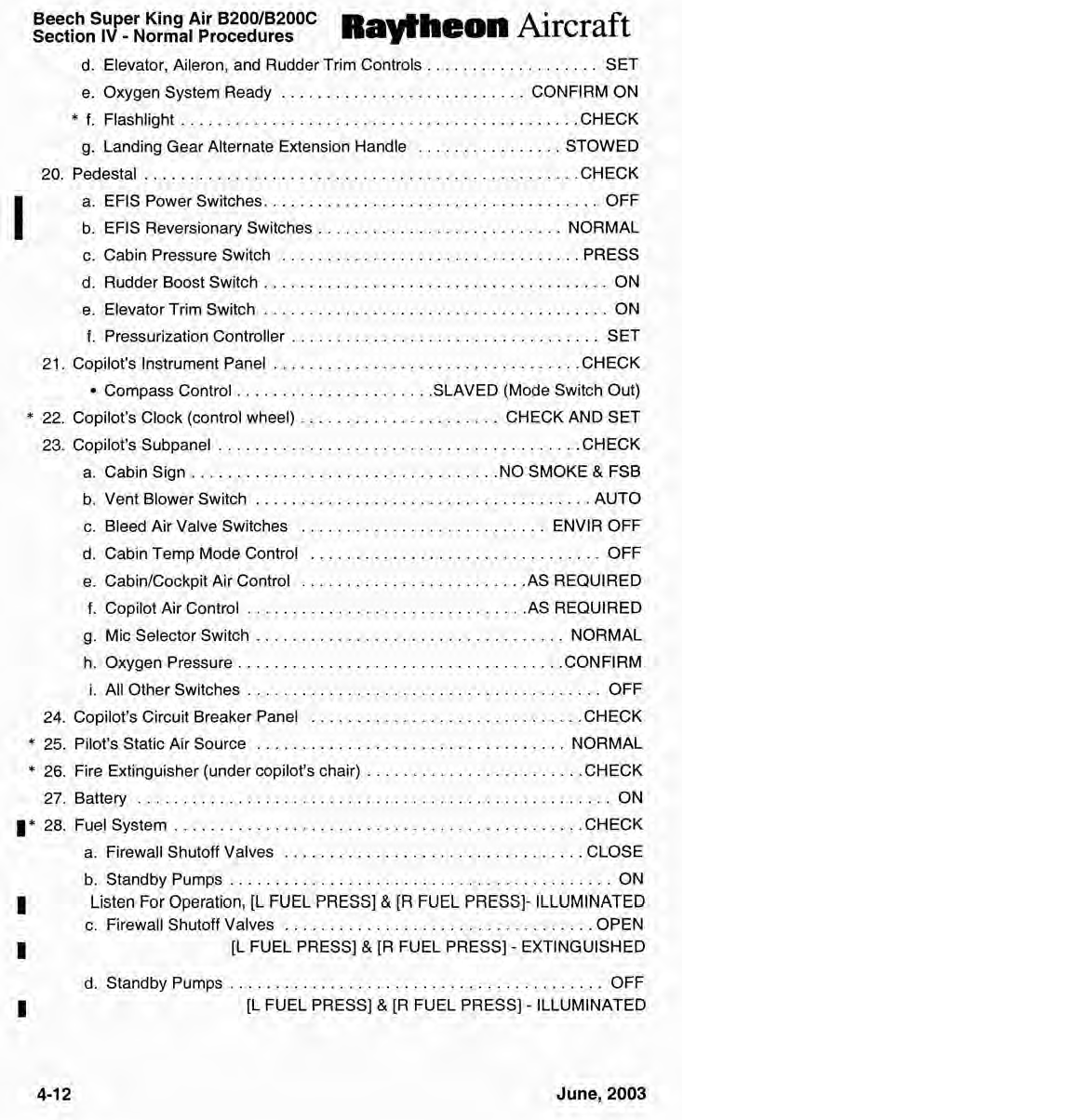

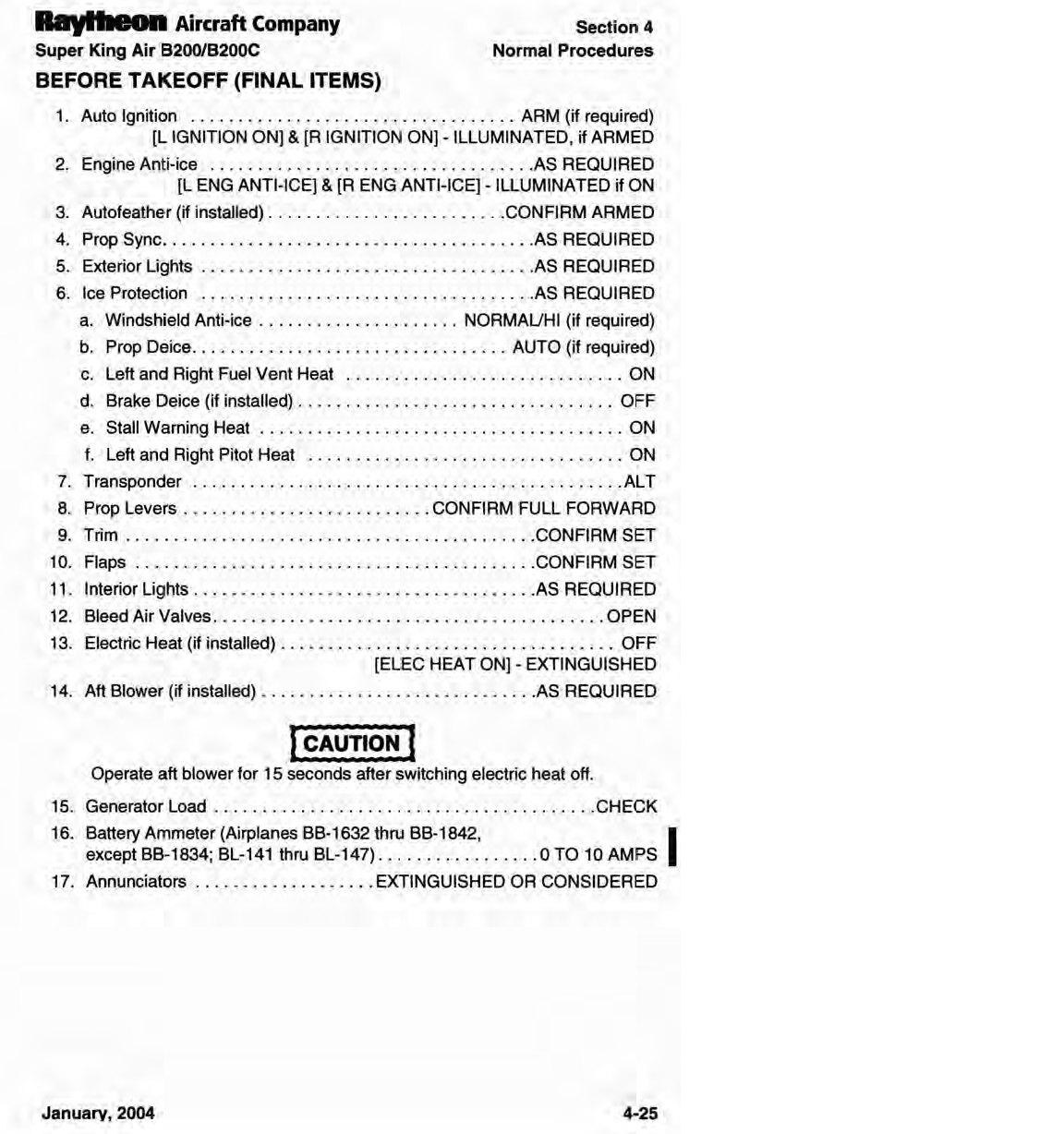
To all, the points in the check list where trims get a mention.








